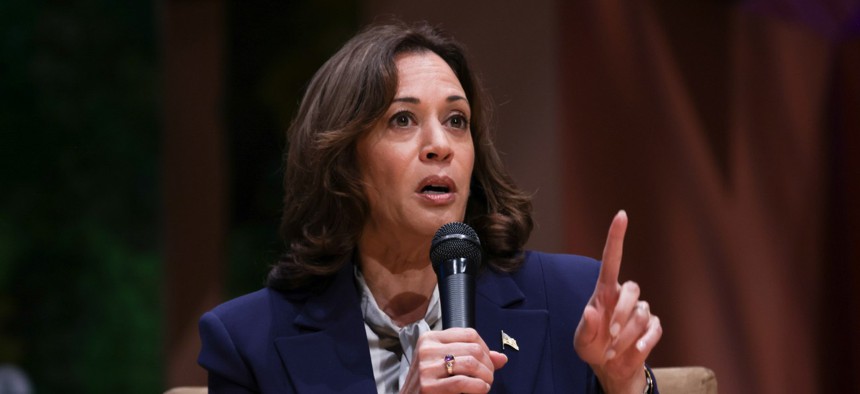
Vice President Kamala Harris is chair of the White House Task Force on Worker Organizing and Empowerment. Mandel Ngan-Pool/Getty Images
Federal Employee Union Membership is Up 20%
Since implementation of a number of pro-labor policies a year ago, federal employee unions gained 80,000 new dues-paying members.
Vice President Kamala Harris’ office last week touted early progress in the Biden administration’s effort to strengthen the federal workforce by improving worker empowerment, boasting a sizeable increase in the number of federal employees who are dues-paying union members.
In February 2022, the White House Task Force on Worker Organizing and Empowerment, chaired by Harris and then-Labor Secretary Marty Walsh, issued its first report, which contained more than 70 recommendations for federal agencies to make it easier for employees in both the federal and private sectors to organize or join a union.
The task force asked federal agencies to foster collaborative relationships with their union partners, involve labor organizations in predecisional policy discussions, and remove barriers from unions trying to increase their membership or organize new bargaining units. The group recommended that the Office of Personnel Management instruct agencies to provide information on whether job openings are represented by unions and encourage agencies to provide unions more opportunities to communicate with new hires.
In a blog post last week, the vice president’s office announced that just a year after agencies began implementing the task force’s recommendations, the initiative is already paying dividends: over the last year, nearly 80,000 federal employees have joined a union, increasing the total number of dues paying union members at federal agencies by 20%. And in the private sector, petitions for union representation increased 53% from fiscal 2021 to fiscal 2022, while overall union membership grew by 273,000 last year.
The task force attributed the boost in union membership to both OPM’s efforts to encourage agencies to improve labor-management relations, including developing an internal agency survey on the issue, and agencies’ efforts to make it easier for union organizers to access federal property, either to contact federal employees or contractors.
“Four task force agencies—the departments of Defense and Interior, the General Services Administration and the Office of Personnel Management—committed to securely and safely make it easier for union representatives to reach potential or current union members to discuss their rights,” the White House wrote. “A fifth agency—the Department of Homeland Security—has since taken action to facilitate access at airports through the work of the Transportation Security Administration. These actions will make it possible for more workers to talk with and hear from union organizers at their workplaces—a significant step in addressing the imbalance of information that exists under current law.”
In the private sector, the Biden administration touted agencies’ work to promote the use of organized labor in federal grants and contracts, including requirements or preferences that encourage applicants for federal spending to have project labor agreements or registered apprenticeships, particularly on projects related to the bipartisan infrastructure law, the Inflation Reduction Act and the CHIPS and Science Act. The blog post specifically cited the Commerce Department’s inclusion of “strong labor standards language” in its grants to expand access to broadband internet, as well as the Energy and Transportation departments’ encouragement of project labor agreements for contractors and grantees.
Additionally, the Labor Department, National Labor Relations Board, Federal Labor Relations Authority and Federal Mediation and Conciliation Service have partnered on a number of educational initiatives.
First, the Worker Organizing Resource and Knowledge Center serves as an online portal with information for employees, companies and agencies to learn about labor issues and how to establish collaborative tools like labor-management partnerships. And the four agencies have collaborated on an initiative to help labor groups and employers negotiate their first union contract.
“The NLRB, FMCS and the FLRA are collaborating on efforts to help parties reach an initial collective bargaining agreement when workers first organize,” the White House wrote. “The agencies have improved the flow of information between their agencies about newly-organized units; expanded outreach to the parties encouraging the use of their agencies’ training and mediation services; and updated and expanded training of agency mediators.”







